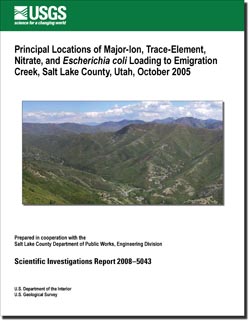Scientific Investigations Report 2008-5043
U.S. GEOLOGICAL SURVEY
Scientific Investigations Report 2008-5043

Prepared in cooperation with
Salt Lake County Department of Public Works, Engineering Division
By Briant A. Kimball, Robert L. Runkel, and Katherine Walton-Day
Housing development and recreational activity in Emigration Canyon have increased substantially since 1980, perhaps causing an observed decrease in water quality of this northern Utah stream located near Salt Lake City. To identify reaches of the stream that contribute to water-quality degradation, a tracer-injection and synoptic-sampling study was done to quantify mass loading of major ions, trace elements, nitrate, and Escherichia coli (E. coli) to the stream. The resulting mass-loading profiles for major ions and trace elements indicate both geologic and anthropogenic inputs to the stream, principally from tributary and spring inflows to the stream at Brigham Fork, Burr Fork, Wagner Spring, Emigration Tunnel Spring, Blacksmith Hollow, and Killyon Canyon. The pattern of nitrate loading does not correspond to the major-ion and trace-element loading patterns. Nitrate levels in the stream did not exceed water-quality standards at the time of synoptic sampling. The majority of nitrate mass loading can be considered related to anthropogenic input, based on the field settings and trends in stable isotope ratios of nitrogen. The pattern of E. coli loading does not correspond to the major-ion, trace-element, or nitrate loading patterns. The majority of E. coli loading was related to anthropogenic sources based on field setting, but a considerable part of the loading also comes from possible animal sources in Killyon Canyon, in Perkins Flat, and in Rotary Park. In this late summer sampling, E. coli concentrations only exceeded water-quality standards in limited sections of the study reach. The mass-loading approach used in this study provides a means to design future studies and to evaluate the loading on a catchment scale.
This report is available online in Portable Document Format (PDF). If you do not have the Adobe Acrobat PDF Reader, it is available for free download from Adobe Systems Incorporated.
Document Accessibility: Adobe Systems Incorporated has information about PDFs and the visually impaired. This information provides tools to help make PDF files accessible. These tools convert Adobe PDF documents into HTML or ASCII text, which then can be read by a number of common screen-reading programs that synthesize text as audible speech. In addition, an accessible version of Adobe Reader 8.0 for Windows (English only), which contains support for screen readers, is available. These tools and the accessible reader may be obtained free from Adobe at Adobe Access.
Send questions or comments about this report to the author, Briant A. Kimball, (801) 908-5047
For more information about USGS activities in Utah, visit the USGS Utah Water Science Center home page.